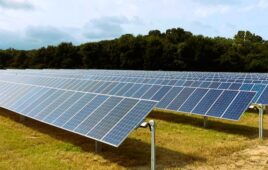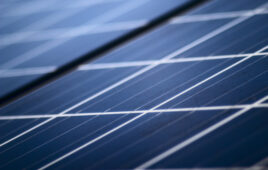Pop quiz: say you have a tree that is shading your array—then you make it 20 ft taller, while also moving it 20 ft farther from the roof. Are you better or worse off? It turns out that the shade losses will usually drop—and this phenomenon is one of the most commonly misunderstood factors that we hear from designers.
Understanding the shape of shade
Many people think the two trees will cast equal shade on the array. However, the impact of changing an obstruction’s height and/or distance vary greatly based on the relative location of the object versus the array. As can be seen in Figure 1, adding distance between the tree and the array will reduce the shade loss more than reducing the height would. For example, note that when a tree’s height grows from 50 ft to 70 ft, the shade impact can be more than offset if the tree is just 10 ft farther away from the solar array.
Said differently, a taller tree that is farther away from the array creates less shade than a shorter tree that is closer to the array. You might have a really scary looking tree that is 100-ft tall, but if it is 70 ft from the array, the shade losses can be negligible.
To understand why this is the case, it helps to look at the shade loss from an object in a more abstract sense. Let’s examine what happens when we simulate a large 100-ft tower surrounded by modules on all sides. Only the modules closest to the tower receive significant shade loss (a few with shade losses above 50%). By the time you are 30 ft from the tower (about six rows of modules) the shading losses drop to under 10%.
Modules farther than 30-ft away are only impacted slightly by the tower, with shade losses on the order of 1 to 4%.
In essence, the shade loss from an object nearly resembles a 1/x curve: it’s very high close to the object, but falls quickly before flattening out at low values.
Real-world manifestation
This concept of relative shade loss comes up all the time with HelioScope users. Most commonly, somebody will design a system near a tree that is 80 100-ft tall. Yet the shade losses from the tree will only be 2 to 3%, sometimes even less. As we troubleshoot, it turns out that the imposing tree is also 100 ft away from the array—and that distance effectively neutralizes the height. An oak in the neighbor’s property is less daunting than a nearby sapling.
Ultimately, the main takeaway here is that our intuition is often wrong with respect to how much shade we should expect from an obstruction. Based on our conversations, it seems like people often focus entirely on the height of the tree or building, and have difficulty factoring in how far away it is. As a result, we are often more hesitant to design around tall obstructions – but if you just run the analysis, you might be surprised at how modest the shade impact is.








I would like elevation diagrams that compare the tree height (and spread?) to sun angles at different latitudes and seasons. Is there a simple angle to the tree top that tells if the shade is bad?
Thank you for this article! I’m trying to figure out the optimal way to move some young trees around so my panels don’t get any more shade than they do.
How does the position of the tree compared to the house make a difference in length of shadow cast (tree on north side of the house vs south side)?
Is it okay to have a clump of trees on the north side of the array when it is facing south? They are evergreens – fir and pine, and the outer branches would only be about 5 feet away from it. Thanks.
Thanks for the article. I live in Nevada, I have been searching for the following information for 2 weeks, I just keep getting solar sales when googling my questions. If anyone can help, I’d appreciate any information.
Where specifically do I find the laws (state/federal) regarding screening ground mount solar panels with trees? My neighbor just put up 42 ground mount panels and we want to require/request they screen with trees to prevent the glare, not to mention the eyesore of our once beautiful view. I’ve been told by our HOA they can’t do trees because they will lose more than 10% of their solar. I’d like to see this law in writing but can’t find. Additionally the solar company was the group that determined trees won’t work and I was under the impression a non biased professional needs to make this determination using specific calculations and write up a report? If so, do neighbors have the right to ask to see said report, is it recorded as a public document?
I also “think” my HOA is correct they can not deny solar no matter the size, because it’s a federal law.
Any help would be very much appreciated.
Thanks
Trees can put shadows on solar panels, limiting their production. So your HOA is correct. Neighbor requests cannot limit the original solar production. Search for solar access laws or solar easements in Nevada. Here’s a little more information: https://www.solarpowerworldonline.com/2018/08/solar-hoa/
Hello… I recently found out NREL’s Solar Advisor Model (SAM) is now open source. There are several versions available but I can’t find an Excel VBA version. I’ve built multiple VBA solar models over the years based on PVFORM and PV Watts. These models aren’t meant to be commercial grade but they’re good basic platforms. Does anyone know of a solar forum with an active solar modeling community?
Hello!
I am Research student working on the “failure mechanism of solar panels.” I would be glad if you can help with useful information on the causes of failures especially in solar street light application.
Paul,
Great article. I was wondering how that relationship may change in the events of a wider obstruction, for example, a tree line or another building. Would the relationship then become more linear?
Paul,
As a solar lighting company, we’re getting into more and more partially shaded environments. We do have someone doing shade analysis internally but I love the user friendly statement “…when a tree’s height grows from 50 ft to 70 ft, the shade impact can be more than offset if the tree is just 10 ft farther away from the solar array.”
Very helpful for communicating with customers. I’ll be sharing your article with our followers.
Great to hear Ilze, thanks!
The main power for my home passes overhead from a street pole to a pole close to my home. Because if trees, the most logical place the panels falls under the shade of the overhead lines. The shadow is about an inch or two horizontally, but would pass though all of the panels.
I was told by one installer that because the shadow is horizontal, I would lose a huge amount of power. Another told me this is old school thinking. The plans call for optimizers.
Can you clear up what’s the real deal and provide a rationale? Thanks